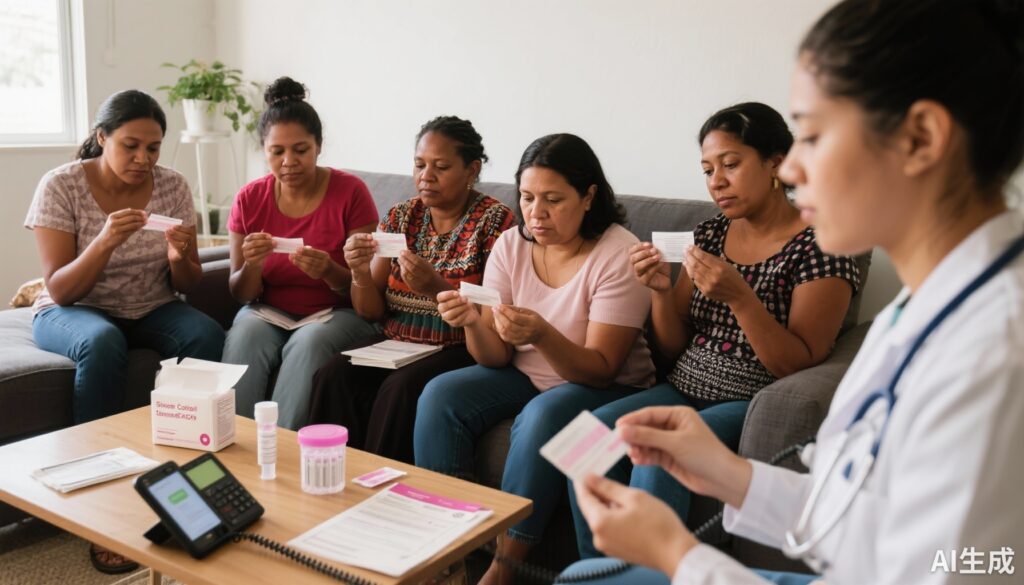Highlight
– Mailed self-collection kits more than doubled cervical cancer screening (CCS) participation compared to telephone reminders alone in an underresourced safety-net health setting.
– Adding patient navigation to mailed self-collection kits provided modest additional gains in screening uptake.
– The majority of trial participants were from racial or ethnic minoritized groups, highlighting the intervention’s effectiveness in populations facing health disparities.
– Self-collection represents a viable, scalable strategy to improve CCS coverage in safety-net healthcare systems with historically low screening rates.
Study Background and Disease Burden
Cervical cancer remains a significant public health challenge worldwide, disproportionately affecting underserved and minoritized populations. Regular cervical cancer screening (CCS) is the cornerstone of prevention through early detection of precancerous lesions. However, underresourced healthcare settings, including publicly funded safety-net systems that serve low-income and minority populations, often experience suboptimal CCS coverage. Barriers such as limited access to clinical services, cultural factors, and logistical challenges contribute to low participation.
Emerging evidence suggests that self-collection of cervical samples for high-risk human papillomavirus (HPV) testing offers a promising alternative to clinic-based screening. Mailed self-collection kits allow patients to collect samples at home, facilitating access and convenience, potentially overcoming structural barriers. Yet, data on the effectiveness of mailed self-collection in safety-net systems remain limited. The PRESTIS randomized clinical trial addresses this knowledge gap by evaluating mailed self-collection kits with and without patient navigation compared to telephone reminders alone to increase CCS participation in an underserved population.
Study Design
This pragmatic, parallel, single-blinded randomized clinical trial was conducted within a publicly funded safety-net health system in Houston, Texas, from February 20, 2020, through August 31, 2023. The study population comprised a random sample of 2,474 cervical cancer screening–eligible patients who were not up to date with screening, including those with no prior documented screening.
Participants were randomized into three intervention arms:
1. Telephone reminder (TR) for clinic-based CCS.
2. TR combined with mailed self-collection (SC) kits sent to patients’ homes, providing an alternative to clinic-based screening.
3. TR combined with mailed SC kits plus patient navigation (PN), where a telephone call from a patient navigator followed mailing of the self-collection kit.
All participants received a reminder call encouraging clinic-based CCS. SC kits enabled patients to self-collect cervical specimens at home and mail them back for HPV testing.
The primary endpoint was CCS participation within six months, defined as either clinic-based screening attendance or return of the mailed self-collection kit. Participation was verified through electronic health record review.
Key Findings
The intent-to-screen analysis included 2,474 participants with a median age of 49 years (IQR 39–57), predominately from racial or ethnic minoritized backgrounds—94.0% represented such groups, including 66.9% Hispanic or Latino, 3.3% non-Hispanic Asian, and 21.6% non-Hispanic Black or African American. Over half (56.1%) of the cohort were enrolled in the county’s publicly funded financial assistance program.
Screening participation at six months was markedly different across groups:
– TR group: 17.4% (144 of 828) completed CCS.
– SC group: 41.1% (340 of 828) completed CCS.
– SC plus patient navigation group: 46.6% (381 of 818) completed CCS.
Relative to telephone reminders alone, the SC group had a 2.36-fold increase in screening participation (95% CI, 1.99–2.80), and the SC plus navigation group had a 2.68-fold increase (95% CI, 2.27–3.16). The absolute difference in screening participation was 23.7% (95% CI, 19.4%–27.9%) for SC and 29.2% (95% CI, 24.9%–33.5%) for SC with patient navigation compared to TR.
These findings demonstrate that mailed self-collection kits significantly improve CCS uptake in an underserved population. The addition of patient navigation further improved participation but with a modest incremental benefit.
Expert Commentary
The PRESTIS trial provides robust evidence supporting mailed self-collection as a highly effective intervention for increasing cervical cancer screening in safety-net settings. Previous barriers such as clinic accessibility, cultural stigma, and logistical challenges often hinder screening uptake in these populations. Self-collection empowers patients with a convenient, private option that aligns with their preferences and schedules.
The trial’s focus on a predominantly minority and low-income population underscores its public health relevance, as these groups bear a disproportionate cervical cancer burden. Patient navigation, while resource-intensive, demonstrated additional but smaller gains, suggesting it may serve as an important adjunct, particularly for patients who experience multifaceted barriers.
Limitations include the single-site design, which may affect generalizability, and the COVID-19 pandemic context, which could have influenced healthcare behaviors. However, the pragmatic nature of the trial in a real-world safety-net system enhances the applicability of findings.
Importantly, integration of self-collection into routine screening programs requires considerations of cost, infrastructure for kit distribution and sample processing, and patient education to optimize returns.
Conclusion
The PRESTIS randomized clinical trial solidifies mailed self-collection as an effective strategy to substantially increase cervical cancer screening participation among underresourced and minoritized populations served by safety-net health systems. Self-collection more than doubled screening rates compared to telephone reminders alone, with incremental improvements from patient navigation. Given persistent disparities in cervical cancer outcomes, self-collection should be incorporated as a core component of screening programs in safety-net settings to enhance coverage, equity, and early detection.
Future research should focus on implementation science approaches to scale these interventions sustainably, assess cost-effectiveness, and monitor long-term clinical outcomes. Enhanced patient navigation strategies tailored to community needs may optimize engagement further.
References
Montealegre JR, Hilsenbeck SG, Bulsara S, et al. Self-Collection for Cervical Cancer Screening in a Safety-Net Setting: The PRESTIS Randomized Clinical Trial. JAMA Intern Med. 2025;185(9):1119-1127. doi:10.1001/jamainternmed.2025.2971
Arbyn M, Smith SB, Temin S, Sultana F, Castle P. Detecting cervical precancer and reaching underscreened women by using HPV testing on self samples: updated meta-analyses. BMJ. 2018;363:k4823. doi:10.1136/bmj.k4823
World Health Organization. Global strategy to accelerate the elimination of cervical cancer as a public health problem. 2020.
Sabatino SA, Lawrence B, Elder R, et al. Effectiveness of Patient Navigation to Increase Screening for Cervical Cancer: A Systematic Review. J Public Health Manag Pract. 2012;18(5):E36-E47. doi:10.1097/PHH.0b013e318235c8bc
Centers for Disease Control and Prevention. Cervical Cancer Screening Guidelines. Accessed 2025.



